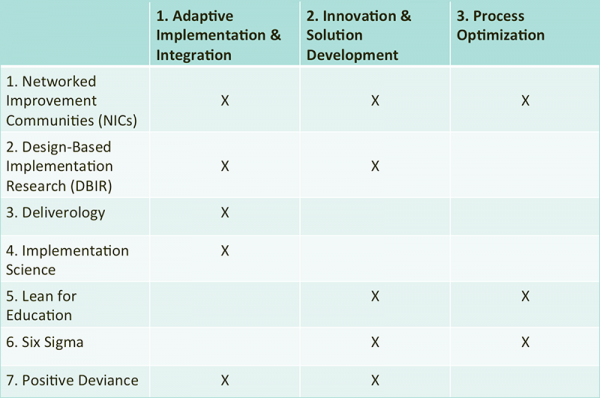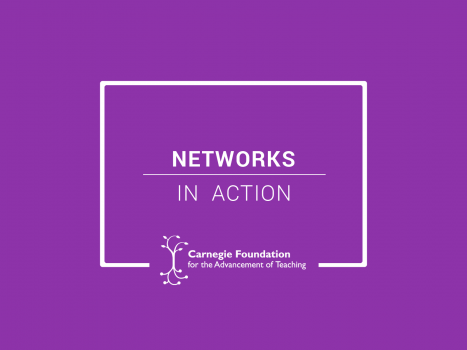Editor’s note: A recent special issue of Quality Assurance in Education explores seven different improvement models being used in schools today. Beginning in February of this year, the Carnegie Foundation began publishing summaries of each of the models on the Foundation’s blog, including process, examples, and pros and cons. The following post provides a summary of positive deviance. To learn more about this improvement method, please see “Positive Deviance: learning from positive anomalies,” by Paul G. LeMahieu of the Carnegie Foundation, Lee E. Nordstrum of RTI International, and Dick Gale with the Institute for Teaching of the California Teachers Association. We hope that these summary blog posts will whet your appetite to delve more deeply into the journal itself.
Unlike the other improvement approaches described in this series, positive deviance (PD) is not a method with its own unique tools, principles, and behaviors, but rather an approach to improvement characterized by uncovering and adapting resources and activities used by organizations, communities, or individuals that succeed in the face of great odds. These outliers, or “positive deviants,” manage to overcome complex problems and significant adversity where others who are similarly situated continue to struggle.
The method was first practiced in 1990, when the non-governmental organization Save the Children was invited by the government of Vietnam to create a program to address the problem of malnutrition in poor villages. Drawing on previous work by researchers at the Tufts University School of Nutrition, members of Save the Children visited the homes of children who were poor yet well-nourished (“positive deviants”), where they observed and identified hygiene and mealtime behaviors that seemed to be making a difference. They later shared these practices and strategies with other members of the community. The positive deviance approach has also been used to address problems such as neo-natal mortality, criminal recidivism, and many issues related to education.
Fundamentals of the Model
Rather than work to identify a problem, analyze the underlying causes, and implement effective practices, practitioners of PD assume that some individual or organization within the community has already done these things, either explicitly or intuitively. The role of PD is to conduct a strategic search to find and learn from these positive deviants.
Once the positive deviant, or outlier, has been identified, a PD team led by a facilitator conducts a thorough investigation into the outlier’s behavior, using interviews and observation to identify which practices produce strong results. The team then determines how to spread this information to others who need it. There are four phases to the positive deviance process:
- Defining the problem and the desired outcomes, and reframing the problem positively;
- Determining the presence of positive deviants by using data collection and observation to identify similar organizations that appear to have overcome similar problems;
- Discovering the uncommon and successful practices and strategies used by the positive deviants identified in phase 2 through inquiry methods;
- Designing opportunities to spread knowledge in practice.
Two additional phases of work are sometimes included in the model: discerning or monitoring the spread of knowledge to others, and disseminating results to external audiences by amplifying success stories.
Positive Deviance in Action
Defining the Problem: This method is best suited to problems in complex social settings that appear to be intractable and therefore require sometimes profound behavioral or social changes. Problems are often first defined by the people they affect. When positive deviance is applied, it should reframe the problems in a positive manner. So, for example, rather than ask why so few academically at-risk students graduate from high school, ask instead what behaviors and strategies are used by the academically at-risk children who do persist until graduation. This approach focuses the community on identifying the positive deviants that exist in their midst.
Merced High School, a comprehensive high school in California’s Central Valley, provides a partial illustration of the PD approach. In the 2008-2009 academic year, Merced High graduated only 80 percent of its seniors, below the national average. The reasons for Merced’s low graduation rate were well known within the community and had resisted numerous change efforts: unemployment in January of 2009 was at 17 percent, with 60 percent of families living at or below the poverty level. The district had a high percentage of non-English speaking students, many of whom were responsible for caring for younger siblings and working to help support their families. And just 20 percent of students completed the courses required for admission to California’s two university systems.
Problems are often first defined by the people they affect. When positive deviance is applied, it should reframe the problems in a positive manner.
Discovering Positive Deviants: The school applied to be part of a Positive Deviance Initiative led by the California Teachers Association’s Institute for Teaching. Eager to get going, Merced High quickly trained a core team that began planning its strategy for identifying positive deviants, meaning students at high risk for dropping out who persisted despite their challenges. They discussed the challenges students face on the path to graduation and learned how to talk with students about these obstacles. In the spring of 2009, the team began conducting video interviews with at-risk students who were beating the odds to understand their experiences and learn about the strategies they used to keep up with their schoolwork.
Identifying Uncommon but Successful Practices: PD assumes that externally developed solutions imported into the community are not as effective as those that arise internally. Community members themselves enact and improve on the positive deviance approach. Through observation and discussion with various community groups (as well as through action techniques such as mapping and diagramming), the improvement team determines the practices and strategies that set apart the high achievers in the at-risk group.
The core PD group held regular meetings to discuss their initial findings and conducted additional student interviews, meeting with small and large groups of at-risk students. Then they opened up the PD project to all school staff.
PD places considerable weight on ensuring that all stakeholders are involved in the improvement process. Merced’s core team held teacher leadership meetings and trainings, and organized a two-day summit for students. Potential solutions identified during this phase were vetted at a community engagement event that drew over 200 teachers, students, parents, and community leaders. Two key characteristics of successful students emerged from these efforts:
- Involvement in school activities, such as sports, drama, band, and student government;
- Relationships with teachers who provided support and encouragement during difficult times.
For a variety of reasons, the effort lost steam for several months. Staff from the Institute for Teaching visited the school at the start of the 2010 spring semester and re-booted the process.

Designing Opportunities to Spread Knowledge Through Practice: During this phase, the PD team tests promising solutions by providing opportunities for people who were not involved in the initial effort to practice the behaviors in a safe environment. While the initiative at Merced did not include a designing phase, Save the Children created an opportunity to spread knowledge through practice when they shared the positive deviants’ successful hygiene and mealtime behaviors with other households in the community. Voluntary training sessions such as these (which both test and spread solutions) tend to start small and last long enough to ensure that the successful behaviors become common practice for participants, who then spread them throughout the greater community.
With input from the community, the PD team begins what’s referred to as the discernment phase of deciding how to measure, monitor, and evaluate the effectiveness of the new practices.
Another aspect of positive deviance that breaks with other improvement models is that its findings do not easily morph into generalized knowledge. Whereas the other models in this series consider adaptability in their designs, PD assumes that every community has its own strategies, behaviors, and practices and that every community must therefore go through the entire PD process. In other words, the PD model does not de facto include dissemination, i.e., the spread of improvement knowledge produced by a local intervention to other contexts.
While there is no systematic way for spreading solutions outside their given context, the learning-by-doing, practice-based approach to sharing knowledge throughout a community is something most educators are familiar with. Additionally, the positive deviance method’s focus on amplifying solutions that already exist may appeal to educators who are wary of yet another one-size-fits-all approach that doesn’t account for local context. Viewed through that lens, PD may be an appealing choice with its emphasis on community involvement and ownership, and the empowerment of affected people to solve their own problems.
Sarah McKay is a former associate for research and communications at the Carnegie Foundation.
June 21, 2017
Three up-and-coming networked improvement communities share common “messy” challenges and helpful advice at Carnegie’s 2017 Summit on Improvement in Education.
July 6, 2021
Carnegie President Timothy Knowles talks with Senior Fellow Dr. Janice Jackson, formerly of Chicago Public Schools, about education, equity, and the future of learning in a post-pandemic school system.






